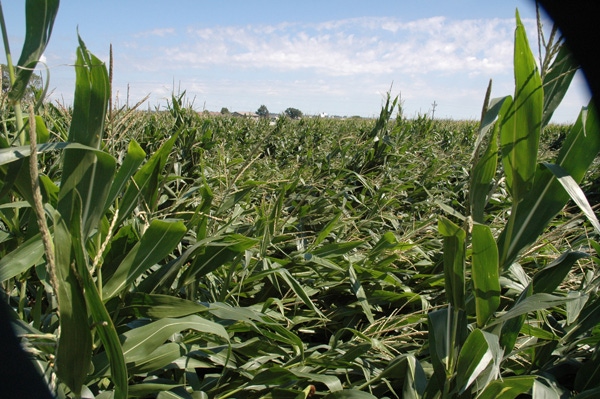July 13, 2011

Is your corn still standing? Tens of thousands of acres were flattened early Monday morning when 100-mph straight-line winds blew from central Iowa across to northern Illinois and southern Wisconsin. Corn that was ready to tassel is now knee-high and struggling to get off the ground and into the sunlight to finish its work for the year. The crop-loss data will be slow in coming out, and could filter into the weekly Crop Progress and Condition Report, but some will not be identified until USDA wades into fields to measure yields for the August Crop Report. What is going to happen to all of that corn?
In the prior Farmgateblog posting Iowa corn was listed more than 80% good to excellent with adequate moisture and only 4% tasseling despite timely planting. Iowa State Crop Specialist Roger Elmore expects most of the crop to move into the tasseling stage this week, including that which may be more horizontal than vertical. The soil moisture report for the past week in Iowa indicated over 80% was adequate to surplus, and Elmore says the damper soils probably allowed more corn to bend downward, and less to break in the form of greensnap. (Small miracle.)
Iowa State Agronomist Mark Licht reported, “Wind damage to corn started north of Woodward and moved east through Slater, Huxley, State Center, Marshalltown and eastward. I’ve heard reports that the damage was 8 miles wide in several areas. From what I’ve seen at this early stage is mostly lodged corn to within a foot of the ground and some slight green snap.” And he adds, “The rule of thumb that I follow is that more than 10 days from tassel, lodged corn will ‘goose neck’ to form reasonable rows. Ten days prior to tasseling the amount of corn that will gain vertical orientation again decreases. And after tasseling very little lodged corn will regain vertical orientation.”
The technical explanation for the 100+-mph winds is offered by meteorologist Justin Gehrts of KCRG television at Cedar Rapids, and says the last such winds that blew through the area were in 1993.
On the topic of crop damage, Elmore says it could take several forms: root lodging, greensnap and pinching.
Root lodging occurs when roots on the windward side are pulled up, and when roots on the leeward side are caused to buckle and can no longer support the downward pressure if the plant is twisting in the wind. Elmore says prior to the tasseling stage, plants have more ability to resume a vertical position, but once ears start to fill out, that ability is lost and goosenecked tops are about all that happens. Elmore says Wisconsin agronomists intentionally lodged corn in the silking stage and recorded yield reduction of 12-31%.
Greensnap is the probable result of wind when corn is growing rapidly, and the stalk breaks at some point. Elmore says, “We’ve learned from previous greensnap events in Iowa and Nebraska that yield loss is directly related to the amount of stalk breakage that occurred. In other words, yield loss from broken plants is directly related to stand loss. If 10% of plants are broken this will result in a 10% yield reduction.” But Elmore says more recent research has shown that a broken stalk may result in an ear loss only 50-73% of the time.
Pinching is the other potential problem, in which the stalk does not break or bend, but folds. They remain alive and will create a gooseneck, with yield losses somewhere between lodging and greensnap.
Elmore says one of his concerns is the fact the region is full of seed production fields. Subsequently, detasseling crews will be earning their money more than usual. He says the bottom line is that if the winds were a week later and more of the crop had tasseled, then less of the crop could pull out of the problem.
In northwestern Illinois, which also recorded high winds and crop damage, pictures are quite graphic of the downed corn, as in a photo taken near Dickeyville, WI. In Monday’s Crop Progress Report from Wisconsin, corn was reported to average 54 in., with 78% in good to excellent condition, and with soil moisture 61% adequate, but 29% short, and some corn beginning to show moisture stress. The data from northwestern Illinois where high winds were also recorded was that 12% of the corn had tasseled, and soil moisture was parallel that of farms just across the Wisconsin border.
Just like with heavy rain events earlier in the growing season, crop insurance will provide some aid, but only if the farm is enrolled. Iowa, Illinois and Wisconsin farmers with downed corn should alert their crop insurance agent before any action is taken or decided.
Summary
Unusually high winds, some in excess of 100 mph, swept across central Iowa and into the northwestern part of Illinois and southwestern Wisconsin. Agronomists say the ability of the corn to return to a more vertical position depends on whether or not it had tasseled. After that point, the plant’s energy goes to seed development, but prior to tasseling, the plant will make an effort to stand up.
You May Also Like




